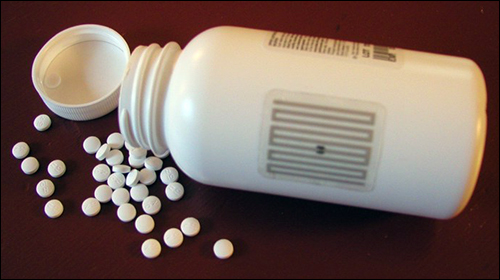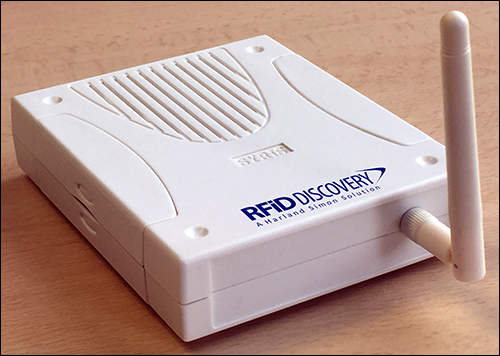The following are news announcements made during the past week by the following organizations:
Brownie, Nedap; TMR Research; Harland Simon; Silicon Labs; and Toshiba.
Fashion Retailer Brownie Signs Agreement With Nedap for Cloud-based RFID Software
Nedap has signed an agreement with fast-growing Spanish fashion retailer Brownie for the supply of its !D Cloud radio frequency identification solution. Brownie uses !D Cloud to raise the in-store stock accuracy of its stores. The rollout took place from May to June 2017.
“The implementation of Nedap’s RFID software is the first step in our digitalization process,” said Albert Puyol, Brownie’s CEO, in a prepared statement. “This technology gives us the stock accuracy level that we need to be a real omnichannel player. Using !D Cloud, we have more insight into our operations than ever before. We now know the product availability and stock depth for each store, and even per location within each store.”

The !D Cloud software suite is specifically developed for retail applications to raise a retailer’s stock accuracy, the company reports. Detailed insights into actual stock levels also make it possible to connect the stock of physical stores with the retailer’s online platforms and offer services like “click and collect.”
During the pre-rollout at three stores, Brownie evaluated the user-friendliness and effectiveness of the solution. “We now have an RFID solution that not only gives us a better stock accuracy, but is also easy to use for our store staff,” Puyol added in the statement. “This significantly increases its effectiveness.”
At Brownie, all items are source-tagged with an RFID label on a hangtag. In the stores, staff members perform a weekly cycle count using a handheld RFID reader and the !D Cloud app on a mobile device. The !D Cloud software then translates the collected data into comprehensive lists that highlight the differences between Brownie’s enterprise resource planning (ERP) system and the RFID count.
According to the company, the causes of stock differences, through losses or administrative errors, can thus be identified and dealt with more quickly. “With the implementation of !D Cloud,” Puyol said in the prepared statement, “we have access to structured and up-to-date information that allows us to make better decisions and significantly increase our sales.”
TMR Research Report Says RFID Revolutionizing Pharmaceutical Industry
A recent report from TMR Research indicates that the market for RFID in the pharmaceuticals industry is currently at the developing stage, with enormous growth possibilities. The study, titled “RFID in Pharmaceuticals Market—Global Industry Analysis, Size, Share, Growth, Trends and Forecast 2017 – 2025,” notes that the U.S. Food and Drug Administration (FDA) has played a pivotal role in escalating the adoption of radio frequency identification in the drug-delivery market, since the technology helps to strengthen anti-counterfeiting and track-and-trace efforts.
Developed by a group of market-research analysts, the report is intended to serve as a business tool for pharmaceutical companies, drug distributors and traders, government regulatory bodies and research associations. The study assesses vital factors that will determine the demand for RFID in pharmaceuticals in the near future, segments the information into smaller aspects and profiles a number of key players in order to gauge the competitive landscape.

According to the report’s findings, RFID technology is proving its proficiency at managing the supply chain, reducing errors with robust storage of information, enhancing staff efficiency in serving patients and decreasing labor requirements, which helps companies to improve patients’ health-care experience. The researchers note that RFID technology has a few hindrances to face, such as tampering issues, compatibility, standardization and technical issues, as well as the high cost of implementation.
Product-wise, the global RFID market for pharmaceuticals is segmented into systems and tags for tracking assets, pharmaceuticals, patients and blood products. Geographically, the report takes stock of the potential of market in all important regions, such as North America, Europe, the Asia-Pacific region, and the Middle East and Africa. North America (with developed countries such as the United States and Canada) and Europe (with the United Kingdom, Germany and France) are the two most profitable regions, the report indicates, though the Asia-Pacific region is expected to increment the demand in the near future, given its improving health-care infrastructure.
Vendors operating in the pharmaceutical RFID market are focused on developing products that not only can improve visibility but are compatible with the delivery package, according to the report. Some key companies currently operating in this market are Hewlett-Packard, Alien Technology, IBM, Motorola, Siemens, Toshiba, Zebra Technologies and Texas Instruments.
Harland Simon Launches New Wi-Fi RFID Reader
Harland Simon, a provider of RFID tracking solutions for the health-care industry, has launched a new fixed RFID reader that communicates with a software database via a Wi-Fi connection. The new device offers the same functionality as standard RFID readers, the company reports, and is intended to lower installation costs by eliminating the need to install new network points.
As a result, hospitals can install readers by plugging them into a normal power socket and registering them via a Wi-Fi network. This, according to the company, reduces installation costs and makes use of a hospital’s existing wireless infrastructure for the automatic location tracking of medical devices. Due to cross-charging practices in place at many hospitals, clinical engineering departments often must pay high costs for the installation of a new network point. When only a network point exists and no power supply is available, the reader can be powered over Ethernet.

The new reader forms part of the company’s RFID Discovery asset-tracking system, used by hospitals throughout the United Kingdom to monitor the locations of mobile medical equipment. By tracking such devices as infusion pumps, syringe drivers, scanners, monitors, feeding devices, mattresses and beds, the system helps hospitals to lower costs by improving utilization levels, thereby reducing the need to purchase additional equipment. The system is designed to help users locate devices quickly, and thus reduces the amount of time workers spend searching for misplaced equipment.
Fixed readers detect the presence of any device fitted with a specialized active RFID tag, then transmit location data back to a central database. Medical engineers and clinical personnel can access the database to locate specific devices.
“Feedback from our clinical engineering users highlighted the challenges and costs many of them face when having to install additional network points,” said Andy James, Harland Simon’s director of commercial operations for RFID Discovery, in a prepared statement. “The launch of the new reader demonstrates our commitment to continually improve our range of hardware to ensure we can deliver suitable options for different requirements.”
Silicon Labs’ Bluetooth Mesh Solution Helps IoT Developers Cut Time to Market
To help developers simplify the design of mesh-networked devices for the Internet of Things (IoT) and get to market faster, Silicon Labs has introduced a suite of software and hardware that supports the new Bluetooth mesh specification. The new Bluetooth mesh solution includes development tools, a software stack and mobile apps supporting Silicon Labs’ wireless system-on-chip (SoC) devices and certified modules. The combination of Silicon Labs’ network-analysis tools and Bluetooth mesh stack for smartphones, the company reports, enables IoT developers to cut time to market by up to six months, compared to existing wireless development tools and techniques.
Bluetooth mesh devices are suitable for smart home, lighting, beaconing and asset-tracking applications. A mesh network enables devices, such as connected lights, to be deployed at greater distances from a hub or gateway. As each light is deployed, the communication range increases, allowing a single gateway to cover an area larger than one that is simply covered by a star network topology. In retail marketing and asset-tracking applications, Bluetooth mesh technology simplifies the deployment and management of beacons. By combining Bluetooth Low Energy (LE) with mesh networking, new capabilities and value can be introduced into devices such as connected lights, which can also serve as beacons or beacon scanners.
“Bluetooth is the next frontier in mesh networking, and Silicon Labs’ new Bluetooth mesh software and tools keep us at the forefront of this rapidly emerging ‘many-to-many’ network topology,” said Richard Baxter, President and CEO of Mesh Systems, an IoT software, services and solution provider, in a prepared statement. “From easy-to-use development kits to mobile applications that help us connect devices seamlessly, we rely on Silicon Labs’ deep expertise in mesh technology to give us the hardware and software resources we need to increase productivity and speed development time so our customers can better compete in today’s IoT race.”
Silicon Labs’ Bluetooth mesh solution includes a suite of development tools and wireless devices. The firm’s certified wireless modules and SoCs include the BGM11S Bluetooth system-in-package (SiP) module and EFR32BG13 Blue Gecko SoCs. Modules with integrated antennas allow users to design Bluetooth mesh-enabled products. Blue Gecko SoCs offer large memory options to support over-the-air (OTA) updates, as well as hardware security acceleration, capacitive sensing, low-power sensor interfaces and enhanced RF performance.
Silicon Labs’ mobile application for smartphones allows designers to verify the operation of Bluetooth mesh-based implementations with a commercially supported Bluetooth mesh library and source code to streamline design. Users can optimize mesh-networking device designs with Silicon Labs’ Simplicity Studio software tools, including network-analysis and packet-trace technology, as well as energy profiling and visual application configuration. Software compatibility across Silicon Labs’ portfolio of wireless SoCs and modules enables broad software reuse.
“We expect to see a wave of new devices hit the market quickly by leveraging ubiquitous Bluetooth connectivity to create hub-less mesh networks that extend the range and reliability of Bluetooth systems,” said Daniel Cooley, Silicon Labs’ senior VP and general manager of IoT products, in a prepared statement. “No matter which mesh technology developers choose to power their next IoT designs, we offer a complete portfolio of silicon, software and solutions that gives device makers everything they need to accelerate time to market while designing secure, robust mesh networks.”
Silicon Labs’ Bluetooth mesh software development tools and software stack are available now, free of charge, to customers with registered Bluetooth mesh development kits from Silicon Labs. Wireless Gecko SoCs, Bluetooth modules and wireless starter kits for Bluetooth mesh applications are available from Silicon Labs and its authorized distributors.
Toshiba BLE Products Now Support New Bluetooth Mesh Standard
Toshiba America Electronic Components (TAEC) has announced that its lineup of Bluetooth Low Energy (BLE) products now offer support for the Bluetooth Mesh standard, recently ratified and launched by the Bluetooth Special Interest Group (see Bluetooth SIG Specification Enables BLE Mesh Networks). The combination of Bluetooth Mesh and TAEC’s application software, the company reports, enables Toshiba’s BLE products to increase communication range, reliability, obstacle penetration capability and battery life.
Combining a non-proprietary mesh solution with Toshiba’s Bluetooth communication system solutions, capable of linking budgets exceeding 100 decibels (dB) with external PA and LNA, allows Toshiba to provide reliable communication in consumer products, the firm explains. It also enables the company to extend support to rapidly growing segments, such as factory automation and building management.
Support for the new Bluetooth Mesh standard enables Toshiba’s BLE products to privately and securely traverse a mesh network rather than requiring a point-to-point connection between devices. This increases the range and reliability of BLE communication without increasing power requirements. Previously, increasing the effective BLE communication range or sending a signal through many walls required higher power transmissions that could negatively impact battery life.
These high-powered transmissions were typically the primary technique used to address such issues as radio interference within a factory environment or the transmission of signals through thick concrete walls. This approach had severe limitations, the company reports, and has proven to be ineffective for power-constrained battery-operated devices, as well as in unfriendly RF environments.
“As a Bluetooth SIG founder and current board member, Toshiba is excited to be among the first to support the organization’s push to increase the effective range and robustness of Bluetooth through the introduction of a highly reliable mesh network,” said Deepak Prakash, a senior director at Toshiba America Electronic Components, in a prepared statement. “This standards-based approach means that new untapped markets, such as industrial and commercial, can now leverage ever-present Bluetooth cell phones or tablets to easily control and monitor their systems.”
In a related effort to increase communication range and signal strength for Bluetooth, Toshiba has introduced new BLE solutions capable of achieving a link budget of more than 100dB using an external PA and LNA. According to Toshiba, the technology provides more than 300 meters of open-air range at low-power transmit and receive levels.

